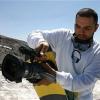
AndreasKielb
Premium Members-
Posts
65 -
Joined
-
Last visited
Reputation
4 NeutralAbout AndreasKielb

Contact Methods
-
Website
http://www.andreaskielb.de
Profile Information
-
Location
Germany
Recent Profile Visitors
-
SL 400 Steadicam Magazines SL-Cine
AndreasKielb replied to AndreasKielb's topic in Steadicam Marketplace - For Sale
Bump, asking 400 USD now... -
Yes, the homebuilt stabilizers site is long gone now but I still use my equipment which I build by the help of this side. Recently we build up a facebook group and uploaded some of the old pictures. Charles, Doug and Cosmin are also there: https://www.facebook.com/homebuiltstabilizergroup/
-
My Heden M28VP stopped working today after my assistant connected an old Aaton power cable, which was part of the kid, instead of the actual FOX analog motor cables. Didn't even notice they had similar connections and that it might be possible to put the 4 pin hirose for power into the motor port. On the Heden site I found out they stopped service for the M28VP in 2016 so I'm a little concerned ( http://heden.se/support/service/ ). Maybe they would repair it anyway but I'll have to wait until monday to find out. Is there another place where I might have it repaired? Meanwhile I had a thought. Maybe there is a safety braker inside the motor which might just gave out due to current on the wrong lines. There was no actual blue smoke or something and also I can't imagine that it's possible to actually kill the internal motor or potentiometer just by wrong electronic connections. The motor would just turn to the opposite direction for reverse polarity, wouldn't it? Possibly destroying the potentiometer mechanically as it hits the end of the 10 turns. But there was no movement at all when he plugged in that cable. It just stopped working. Backup M26P motor still worked with the FOX so it's not the output driver.
-
Which steadicam / gimbal with Ursa mini
AndreasKielb replied to Tiago pimentel's topic in General Discussion
I'm not that familiar with the different ronin versions. From the specs the MX might work as well, wouldn't it? It's also much lighter than the original ronin. -
Which steadicam / gimbal with Ursa mini
AndreasKielb replied to Tiago pimentel's topic in General Discussion
You would need a normal Ronin with that load. I used the combination with the steadicam not long ago and it's actually a great thing. I'll use it more often in future. If you don't need the high to low mode movements you can connect the gimbal directly to your topstage with the cinemilled plate. Once the camera is balanced in the gimbal you can change from handles to steadicam in less than a minute using the quick release so there is really no need to carry the gimbal by hand if not necessary. The steadicam is much better suited for longer takes and eye level. -
Qbranch Qlite problems: solutions?
AndreasKielb replied to Joshua Gitersonke's topic in General Discussion
Yes Alex, that is the problem if you have an Alexmos controller without good support and usable settings and a very wide range of cameras regarding weight and size. But if you have good settings for an Alexa mini, Master primes and remote focus, these settings do normally work with an Epic or Sony F5/F55 with lenses of similar size as well. Having a system with a roll axis only is also generally less difficult to support than a 3 axis system. The Alexmos controller is meant for very different setups and therefore provides a full PID control loop and many other options. It's quite easy to get lost in the software if you have no experience with it and then you end up with a system which doesn't seem to work at all. It's also possible that the system doesn't hold level in pans if the IMU isn't calibrated correctly and the encoders also need to be set up in a specific way. It was of course a huge mistake to offer the Omega lite with big promises and no user support at all. But I think as so many unused systems are around and the chances of Howard stepping in with a valid user support or refunds are minimal, it's worth a try to get those system working within a limited range of equal cameras and lenses at least. -
Qbranch Qlite problems: solutions?
AndreasKielb replied to Joshua Gitersonke's topic in General Discussion
I don't own an Omega Lite but I have good experience in building and tuning Alexmos gimbals. I thought that I might be able to help you out with greating usable settings and also user support later on. I also have sold a few custom build gimbals under the label http://www.portahead.de before the Ronin came out and so I'm used to give support on telephone. Fortunatelly the Alexa Mini and Epic and also Sony F5/F55 cameras are very similar in size and weight and it might be possible to use them with the same settings. Maybe somebody of you is willing to send me a one of the systems which doesn't seem to work to test with for free or very little money. If the others, who want to stick with their system, pay like 300- 500 Euros each for my support to him later, that might get him an acceptable refund of around 3000 Euros in the end. First thing would of course be that I can get one unit to work as it is or maybe with a new board. As you know the boards a very inexpensive so that wouldn't actually change the deal. If I doesn't succeed with getting the unit to work at all, I'll send it back to him so there would be no difference to the situation as it is now. I think it would be unrealistic to be able to use a full size Alexa with the system like it is now, though. Maybe it's possible to fit in a bigger motor instead of the existing one mechnically. Please let me know if my idea is interesting for you. Andreas -
SL 400 Steadicam Magazines SL-Cine
AndreasKielb replied to AndreasKielb's topic in Steadicam Marketplace - For Sale
Pricedrop: Asking 800 USD now. -
I tried the Trinity at the IBC for the first time and have the feeling that the joystick control of the tilt axis was already improved compared to the version of the MagPie promo. At least I think it's possible to maintain a good headroom in a one-shot with that joystick control after a few takes and the chance to learn what is going on. But I do have an issue with the direct connection between sled and pan axis. With a vertical sled the direct connection is of course a good thing but with the low inertia of a horizontal sled in mid mode it's really difficult not to add unintended movements to the pan axis. But I guess the 'around the corner looking function' is an integral part of the rig and is caused by the arrangement of the tilt axis being the outer and roll the inner axis. If it's not a given mechanical fact I'd say it would be better to have the pan axis fixed electronically and not connected to the rotation of the post. Then you'd have the entire inertia of the long post to keep pans perfectly stable in mid mode (...by pointing the rig in the desired direction). But if I'm not mistaken it is a mechanical thing and it would be necessary to reverse the arrangement of tilt and roll completely, having roll as outer axis and tilt inside so that the tilt motors are always level together with the camera.
-
Automated Horizon on a steadicam
AndreasKielb replied to Michael Hauer's topic in Camera Stage/Donkey Box
When I tried the WXB last Cinec the rig was set to zero drop time actually with the WXB providing a kind of virtual bottom heaviness or resistance to sideways tripping. As James already said it achieves that effect by shifting a brass weight in small increments according to feedback it gets from a Wagner IMU. It worked great and I was very impressed by the system. -
I'm selling my analog Bartech remote focus set (transmitter and receiver). It's in nice condition and comes in the original case. Located in Germany / Europe. 1300 USD List of equipment name, model number, quantity, serial number: - 1x Bartech handheld units S/N: T1.0550 - 1x Bartech receiver S/N: R1.0550 - 1x motor cable - 3x marking strips
-
WTB Arri 35-3 Steadicam Mags
AndreasKielb replied to Joe Gill's topic in Steadicam Marketplace - Wanted
Hi, I've two SL-Cine steadicam mags for sale which are designed for the Arri 35-3 but lighter and in excellent condition. They come with a custom case (see attached pictures): http://www.steadicamforum.com/index.php?showtopic=21912 -
Selling a case of two SL 400 steadicam mags in excellent condition. I'm asking $950 USD. http://www.slcine.com/html/stead2.html These magazines will work with the Arriflex 35- 3, Arri 2C, SL-Cine 35 mm and also Arri 435 and Arri 235. On the Arri 435 and 235, the mags sit on a slight downward angle but still without shifting the balance considerably as standard mags would. They are made of a magnesium material, making them very very light, lighter than 435 Steadicam mags. A footage counter is built into the cover. Weight: 56 oz (1.5 kg) New price for the mags is $4250 USD each. They will run up to 130fps in forward only. The magazines are located in Germany. email: andreaskielb@web.de
-
Portahead 10 brushless gimbal with Arri Alexa on steadicam
AndreasKielb replied to AndreasKielb's topic in General Discussion
The rig length is only because I heave fairly light weights at the bottom of my sled. It's actually the same conventional with heavy cameras up to 15 kg and if there is a bridge plate under the camera which increases the distance to the topstage. But having a long post doesn't bother me actually. I need to limit the overall rig weight to 23 or 24 kg as that's the weight limit of my arm. At the moment my attempts are mainly to explore the possibilities of this new technology in combination with the steadicam and to get a rig which allows dolly-like shots under all circumstances. It's just to add an extra bit of perfection. If you are interested I already wrote a little technical description about why I think that improvements are possible with the combination of brushless gimbals and steadicam which go beyond using both systems on their own: http://www.steadicamforum.com/index.php?showtopic=21005&p=103777 A more integrated system which allows low to high mode shots on steadicam for heavier cameras is also in the planning but will require CNC machining and probably a cooperation partner. I already built a system for lighter cameras and with available parts, though:- 24 replies
-
- brushless gimbal
- alexa
-
(and 2 more)
Tagged with:
-
Portahead 10 brushless gimbal with Arri Alexa on steadicam
AndreasKielb replied to AndreasKielb's topic in General Discussion
It might seem odd to put additional weight on the steadicam which already does a great job in stabilization. But at the moment there are a lot of shots that usually don't utilize a steadicam and the reason is often explained with a gesture that insinuates a slight sway, like for instance a pack shot for a commercial. I won't suggest auto-levelling is a game changer but it might be a helpfull tool anyway.- 24 replies
-
- brushless gimbal
- alexa
-
(and 2 more)
Tagged with:











